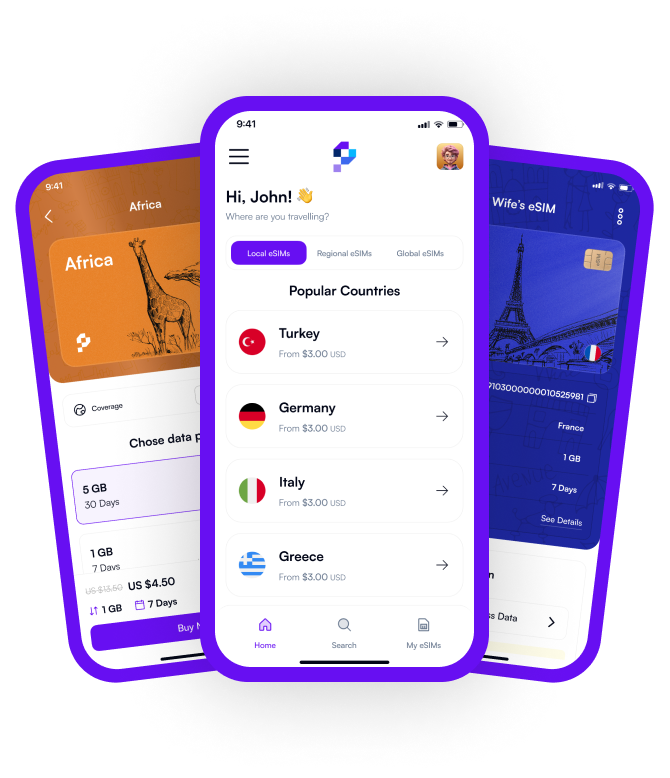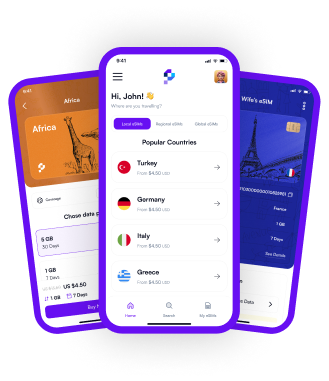Getting an eSIM in Canada typically involves a straightforward process, primarily offered by major mobile carriers. First, ensure your device supports eSIM functionality, as not all phones do. Then, check if your carrier provides eSIM services. Most major carriers like Bell, Rogers, and Telus offer eSIM support for compatible devices. You can either visit a physical store or manage your eSIM activation online through the carrier's website or app. Typically, you'll need to provide some personal information and your device's IMEI number to activate the eSIM. Once activated, you'll receive a QR code or activation code to scan or input into your device, enabling the eSIM functionality.
Alternatively, if you're looking for more flexibility or specific eSIM plans, there are also third-party eSIM providers in Canada. These providers often offer eSIM plans for travelers or users seeking alternative options to traditional carriers. Research and compare different eSIM providers to find the best fit for your needs. Keep in mind that while eSIM adoption is growing, it may not be as widely available as traditional SIM cards, so it's essential to verify compatibility and availability with your device and desired carrier before making the switch.
How Do I Setup eSIM in Canada?
Setting up an eSIM in Canada is a relatively simple process that can typically be done entirely online or through your device settings. First, ensure your device supports eSIM functionality. Then, if you're a new customer, you'll need to purchase an eSIM plan from your chosen carrier or third-party provider. If you're an existing customer, you may be able to switch your physical SIM card to an eSIM through your carrier's website or app.
Once you have your eSIM plan or have converted your physical SIM to an eSIM, follow the instructions provided by your carrier or device manufacturer to activate the eSIM. This usually involves scanning a QR code or entering an activation code provided by your carrier. After activation, your device should recognize the eSIM, and you'll be able to use it for calls, texts, and data just like a traditional SIM card. Keep in mind that the exact steps may vary slightly depending on your device and carrier, so it's essential to follow the specific instructions provided by your provider.
How Much is eSIM in Canada?
The cost of an eSIM in Canada can vary depending on the carrier and the specific plan you choose. Generally, eSIM plans are priced similarly to traditional SIM card plans offered by carriers. The cost typically includes monthly service fees for data, calls, and texts, as well as any additional features or add-ons you select, such as international calling or roaming packages.
Additionally, some carriers may offer promotions or discounts for eSIM plans, especially for new customers or as part of bundled packages with other services like home internet or TV. It's essential to compare the prices and features of different eSIM plans from various carriers to find the best option that fits your needs and budget. Keep in mind that while eSIMs may have an initial setup cost, they can provide convenience and flexibility, especially for travelers or users who frequently switch between devices.
Does İphone Support eSIM in Canada?
Yes, iPhones support eSIM functionality in Canada, allowing users to take advantage of the benefits of eSIM technology. iPhones starting from the iPhone XS, XS Max, XR, 11, 11 Pro, 11 Pro Max, SE (2nd generation), 12, 12 mini, 12 Pro, and 12 Pro Max are all equipped with eSIM capabilities. This means that users with compatible iPhones can use eSIMs in addition to or instead of traditional physical SIM cards to connect to cellular networks.
To activate an eSIM on an iPhone in Canada, users can typically do so through the device's settings menu. They can add an eSIM plan by scanning a QR code provided by their carrier or entering an activation code. Once activated, the iPhone will recognize the eSIM, and users can manage their cellular plans directly through the device settings. This provides flexibility for users to switch between different carriers or plans without needing to physically swap SIM cards, making it particularly convenient for travelers or those who frequently change their mobile plans.
Can I use both eSIM and physical SIM in Canada?
Yes, you can use both an eSIM and a physical SIM card simultaneously in Canada, provided that your device supports dual SIM functionality. Many modern smartphones, including iPhones and select Android devices, offer dual SIM capabilities, allowing users to utilize both an eSIM and a physical SIM card at the same time. This feature is particularly beneficial for users who want to maintain two separate phone numbers or use different carriers for personal and business purposes.
To set up dual SIM functionality on compatible devices, users can activate the eSIM as their primary line and insert a physical SIM card into the device's SIM tray for the secondary line. Users can then configure their device settings to specify which line to use for calls, texts, and data, or set default preferences for each type of communication. With dual SIM support, users can enjoy the flexibility of having two active phone numbers on a single device, enhancing connectivity and convenience without the need for multiple devices or constant SIM card swapping.
What is Advantage of eSIM ?
eSIM, or embedded SIM, offers several advantages over traditional physical SIM cards. One significant advantage is its flexibility and convenience. With eSIM technology, users can easily switch between different mobile carriers or plans without the need to physically swap SIM cards. This flexibility is particularly beneficial for travelers who frequently visit different countries or regions, as they can simply activate a local eSIM plan upon arrival, eliminating the hassle of purchasing and installing a physical SIM card.
Moreover, eSIMs save physical space within devices, as they are embedded directly into the device's hardware rather than requiring a separate SIM card slot. This streamlined design allows for sleeker and more compact devices, as well as potentially enabling manufacturers to allocate more space for other components such as larger batteries or improved cooling systems. Additionally, eSIMs are more resistant to damage or loss since they are not removable, reducing the risk of SIM card-related issues such as misplacement or accidental damage. Overall, the convenience, flexibility, and durability of eSIM technology make it an attractive option for modern mobile devices.
What If I Lose My eSIM Activated Device?
Losing an eSIM-activated device presents some unique challenges compared to losing a device with a traditional physical SIM card. One immediate concern is the security of the eSIM and the personal data associated with it. If your eSIM-activated device is lost or stolen, it's crucial to take immediate action to prevent unauthorized access to your mobile service and sensitive information. Contact your mobile carrier as soon as possible to report the loss and request that they deactivate the eSIM associated with your device. Most carriers have procedures in place to suspend or deactivate eSIMs remotely to prevent unauthorized use.
Once you've reported the loss of your eSIM-activated device to your carrier, consider taking additional security measures such as remotely locking or wiping the device if possible. You may also want to change passwords and enable two-factor authentication on any accounts linked to the lost device to further protect your personal data. If you have insurance coverage for your device, contact your insurance provider to inquire about the process for filing a claim for a lost or stolen device. By taking prompt action and following these steps, you can help minimize the potential risks and consequences associated with losing an eSIM-activated device.
How Does eSIM work in Canada?
eSIM, or embedded SIM, works in Canada much like it does in other countries where it's available. Instead of using a physical SIM card to connect to a mobile network, eSIM technology allows users to activate a virtual SIM card directly on their compatible device. In Canada, major mobile carriers like Bell, Rogers, and Telus offer eSIM support for compatible devices. Users can typically activate an eSIM plan online through the carrier's website or app by scanning a QR code or entering an activation code provided by the carrier. Once activated, the device recognizes the eSIM, and users can use it for calls, texts, and data just like a traditional SIM card.
One of the key advantages of eSIM technology in Canada is its flexibility. Users can easily switch between different carriers or plans without needing to physically swap SIM cards. This flexibility is particularly beneficial for travelers who frequently visit different regions or countries, as they can activate local eSIM plans upon arrival without the need for physical SIM cards. Additionally, eSIMs save physical space within devices since they are embedded directly into the device's hardware, allowing for sleeker and more compact designs. Overall, eSIM technology offers convenience, flexibility, and versatility for users in Canada and around the world.
Does eSIM work without Internet?
While eSIM technology itself does not require an active internet connection to function, the initial setup and activation process typically do. To activate an eSIM, users usually need to connect to the internet to download the necessary eSIM profile from their mobile carrier or service provider. This profile contains the information required for the device to connect to the carrier's network, such as the SIM card identifier and network settings. Without an internet connection, users would not be able to download this profile and activate the eSIM.
Once the eSIM is activated and the profile is downloaded onto the device, it can function without a continuous internet connection for basic cellular services like calls, texts, and data. However, certain advanced features or functionalities may require periodic internet access, such as software updates, carrier profile updates, or accessing carrier-specific services like visual voicemail or Wi-Fi calling. Overall, while eSIM technology itself does not rely on an internet connection to operate, the initial setup and ongoing maintenance may require internet access.

